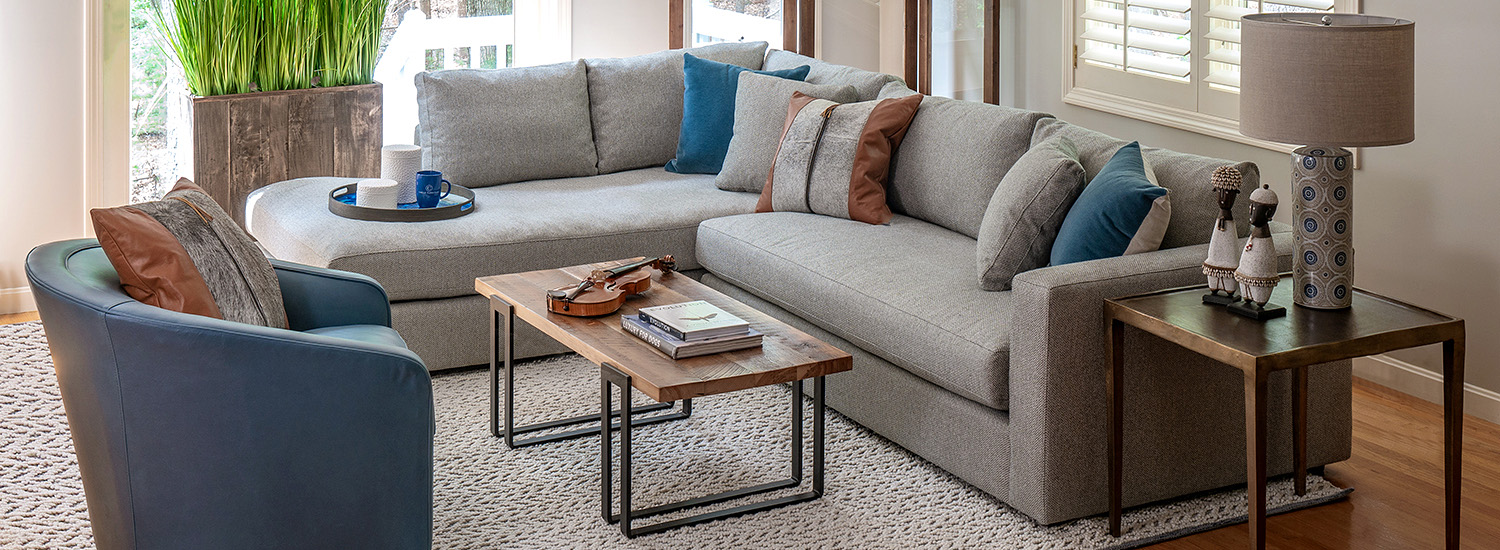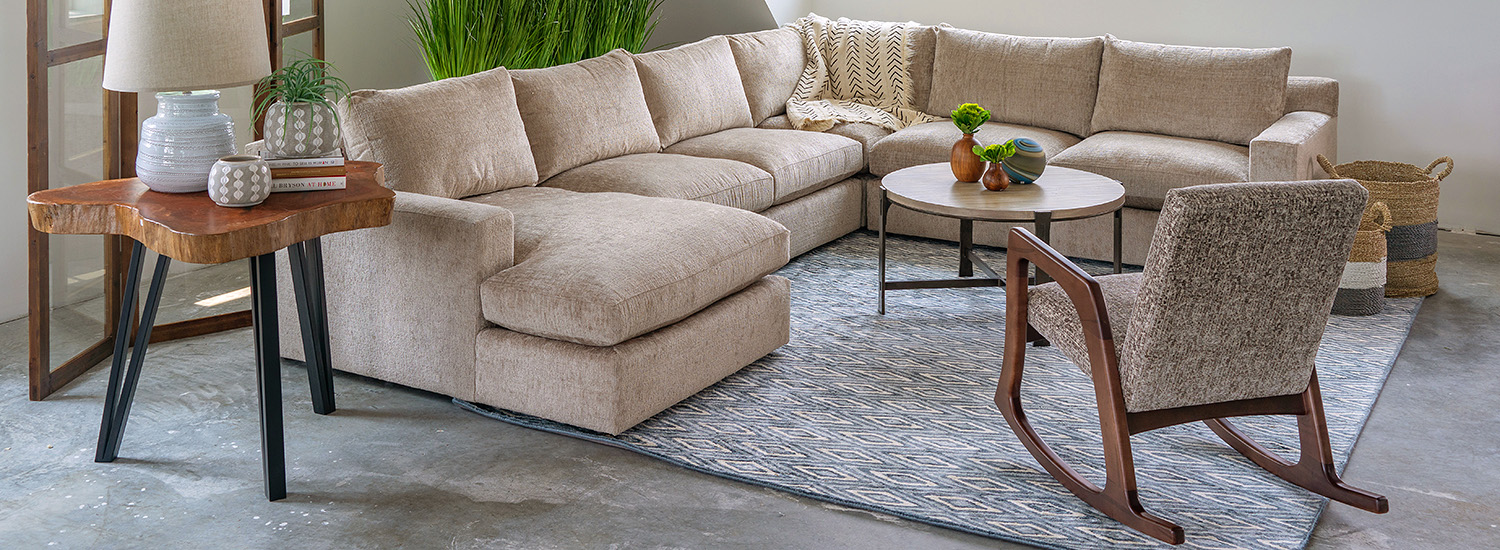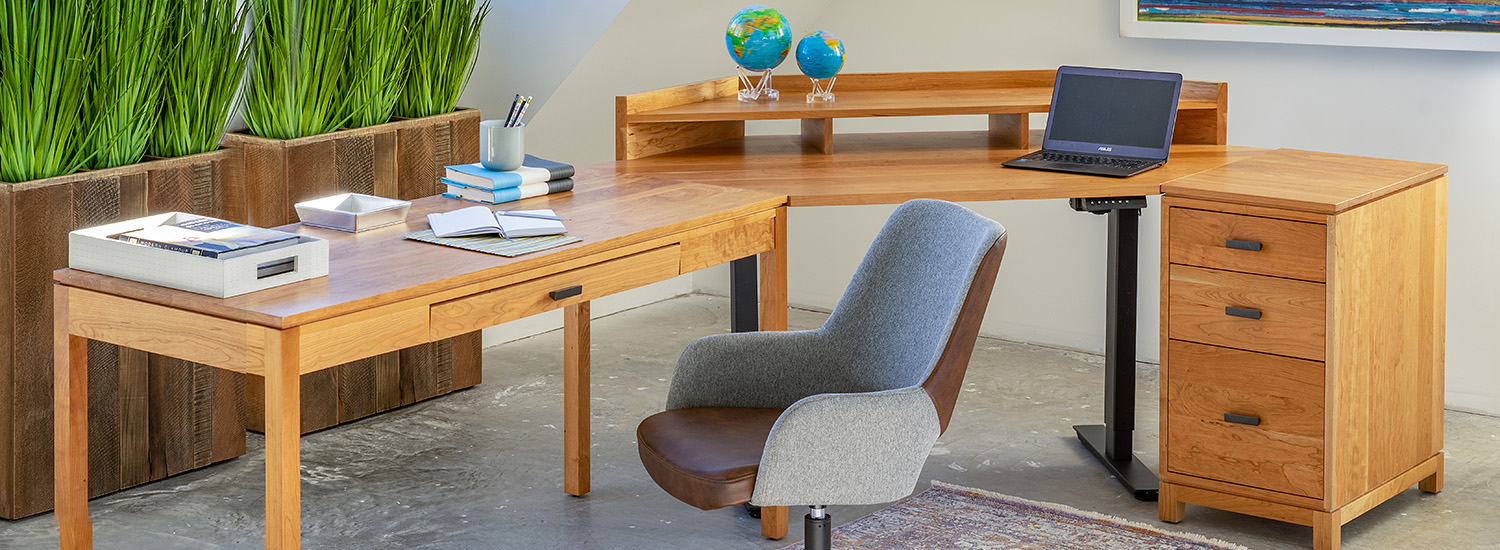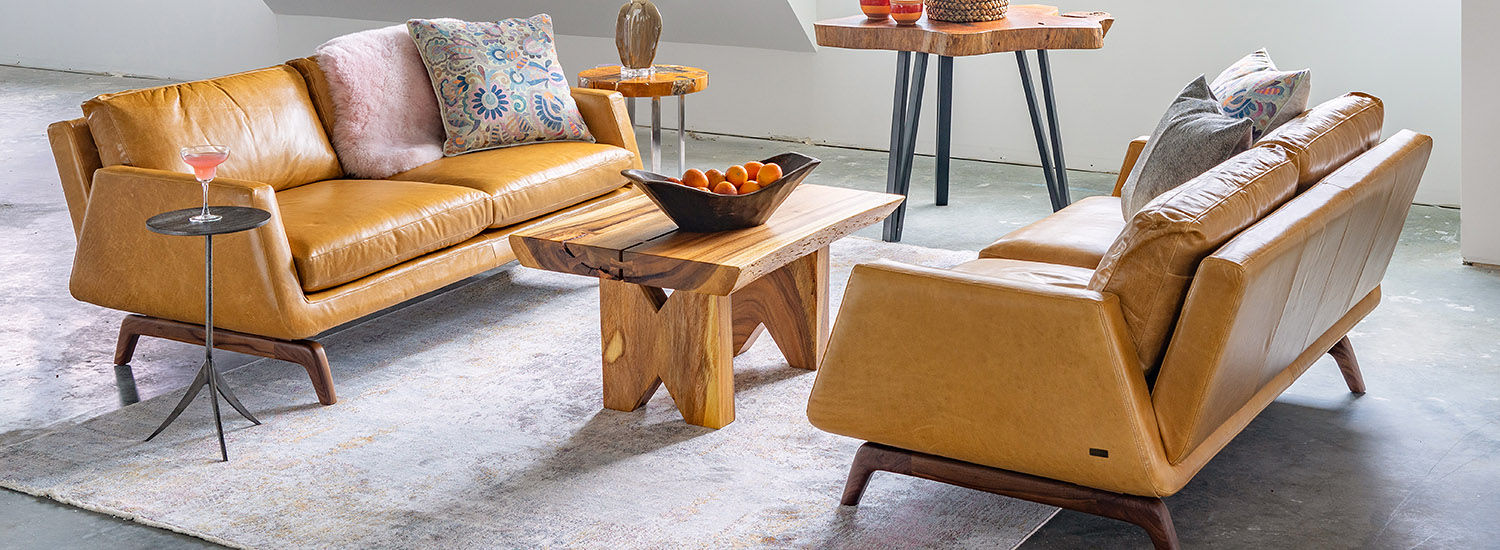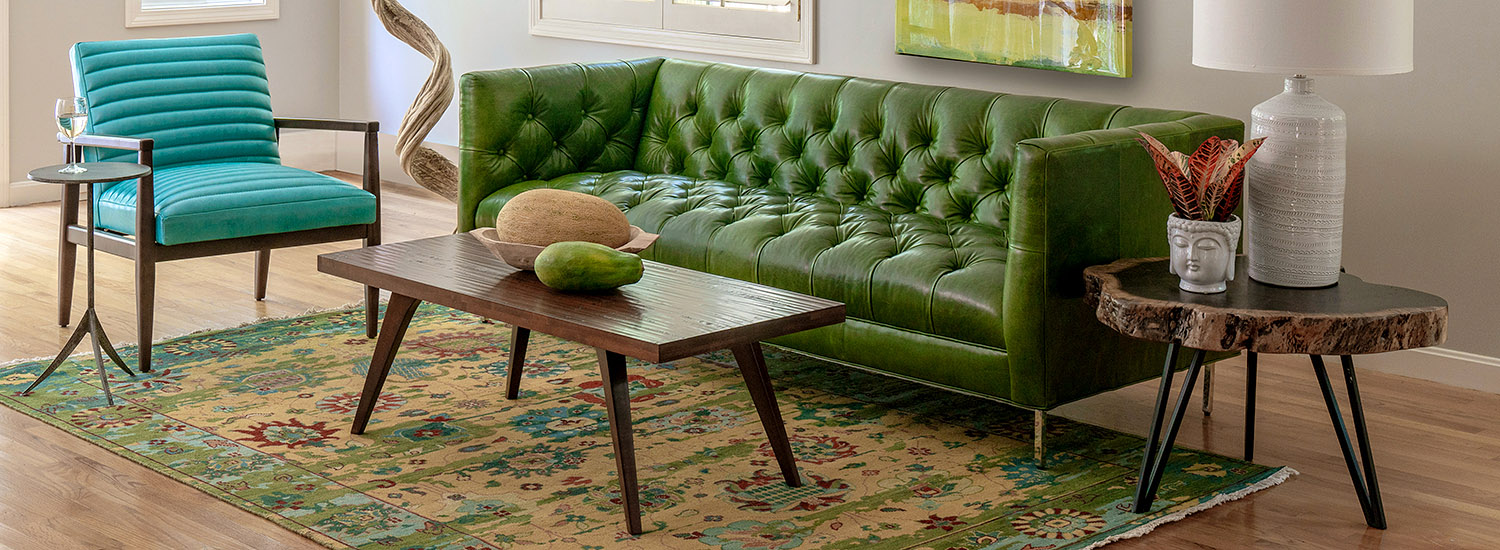Circle Furniture is proud to carry high-quality furniture that’s built to last. We believe that sourcing the best possible materials makes all the difference. However, we also know that how you care for and clean your furniture will affect its longevity. That’s why we created this comprehensive guide for you.
We wanted to give you a resource for all of your furniture care needs so you don’t have to spend hours researching. Everything you need to know about taking care of your area rugs, fabric, leather, and wood furniture is here.
1. Area Rug Care
2. Fabric and Upholstery Care
3. Wood Care
4. Leather Care
1. Area Rug Care
As with anything you invest money into, it’s important to take care of your area rugs to prevent wear and tear. The best course of action is to clean and maintain your rugs on a regular basis—even if it doesn’t look like they need it!
First, invest in rug pads
- They prevent rugs from slipping, extend the life of the rug, and protect your floors
- We recommend getting a rug pad for every area rug, from the small to extra-large, including those with latex backing.
Clean your rugs
A periodic professional cleaning will keep area rugs looking great and extend their longevity. To spot clean or blot spills use a clean white cloth. Vacuum regularly, avoiding the beater bar (use the “floor” setting).
Here are a few specific tips:
Wool or Jute Rugs:
- Use scissors to trim yarn evenly with rug surface.
Polypropylene Rugs:
- Rinse rug with a hose and hang until thoroughly dry.
- Use scissors to trim yarn evenly with rug surface.
Polyester Rugs:
- Rinse rug with a hose and hang until thoroughly dry.
- Do not use harsh chemicals.
Bamboo/Viscose or Wool/Viscose:
- Clean spills immediately with a minimal amount of water and mild soap.
Rotate your rugs:
Traffic patterns may cause a wear-out pattern if your rugs are never rotated. By rotating them you will prevent this from happening, thereby extending the longevity of the rug.
2. Fabric and Upholstery Care
The Basics
Weekly Care
- Flip, fluff, and rotate loose seat and back cushions at least once a week to distribute material and wear evenly.
- Vacuum all fabric weekly using the upholstery attachments to pick up any loose particles and debris that could cause your upholstery to wear.
- Avoid placing your furniture in direct sunlight. All fabrics will fade over time.
- Place furniture cups or non-skid disks underneath legs to help protect your floors and carpet.
- Periodic cleaning by a professional upholstery cleaning service is highly recommended.
Long-Term Care
Take your upholstery to a professional upholstery cleaning service to maintain or if there’s a serious stain.
Fading:
All fabric will fade over time, although how fast this occurs is largely determined by the material content, color, and the amount of direct sunlight to which the piece is exposed.
Pilling:
Fabric pilling is normal. Pilling can be controlled through the use of a fabric shaver; available at most fabric shops. Pilling will eventually cease over time if maintained through shaving. Shaving does not affect fabrics performance or longevity.
Standard Cleaning Codes:
W: Water-based cleaning agents or foam may be used. Never use tap water. Use distilled water, as tap water contains minerals that may cause rings or fading.
S: Only mild, water-free cleaning solvents should be used. Never use water. Do not dry clean in parts.
SW: Water-based cleaning agents, foam or mild water-free cleaning solvents may be used. Never use tap water. Use distilled water, as tap water contains minerals that may cause rings or fading.
X: Clean only by vacuuming or light brushing to remove overall soil. Never use water, foam or liquid cleaning agents.
Note: For prewashed fabrics upholstered onto a frame, follow the S cleaning code.
3. Wood Care
The Basics
The first step in wood care is to consider the natural characteristics of solid wood.
Although wood is naturally beautiful, it is far from flawless. It is natural for wood to have knots, mineral deposits, worm holes, and unusual grain patterns. Each piece is as individual as a fingerprint and will take stain slightly different—even two boards from the same tree. This is an inherent quality of wood and is not a defect unless it interferes with the service of a product.
Wood Furniture Care Tips
- Avoid placing your furniture in highly humid or dry areas, such as directly next to air vents. Direct sunlight may darken wood furniture.
- Use coasters and tablecloths or placemats when dining to avoid scratches and dings and water rings.
- Place trivets under all serving dishes, especially beneath hot plates to keep heat from damaging the finish.
- Wipe up spills immediately. Tough, sticky spots may require a small bit of hand dish soap, but be sure to rinse clean with a damp cloth and dry any excessive moisture.
- Clean your wood furniture with a lint-free, lightly water-dampened cloth.
- Dust with a soft, dry cloth. Even dust particles can be abrasive, so always dust with the grain and not against it.
- Do not use harsh chemicals or abrasives on any finish.
- Store table leaves properly. They should be placed flat. They can warp if placed on their sides.
- We strongly discourage standing on or tilting back in chairs while seated; it is dangerous & will loosen the joints. (Decorative wood spindles are fragile and will break when subject to undue stress).
4. Leather Care
The Basics
Care Tips from the Makers
American Leather and Stressless are known for carrying high-quality leather sourced from the finest tanneries. They carry several different types of leather, ranging from the most delicate to the sturdiest. With the following techniques, you’ll learn how to properly maintain your leather furniture so that it ages like fine wine.
American Leather Styles
Light Protection – The softest and most supple aniline leather, it has natural hide marks and requires more care and attention.
Medium Protection – This option has a protective coating but still retains the softness.
Heavy Protection – The most durable of the leather options, a heavily pigmented coating creates a barrier against spills, etc. It’s a great option for families.
American Leather Recommended Cleaning Techniques
- They recommend protecting your furniture from the sun and direct light.
- They recommend dry-cloth dusting and vacuuming in crevices and along the bottom.
- They also recommend applying a good leather conditioner every six to 12 months.
- They do not recommend using saddle soap, cleaning solvents, furniture polish, oils, varnish, abrasive cleaners, detergent soaps, or ammonia water.
- For minor scratches: they advise moistening it lightly and using clean fingers to buff the scratch.
- For minor spots and spills: wipe excess liquid up with an absorbent cloth and, if necessary, use a dampened cloth with distilled water and let it air dry.
- For stubborn stains: moisten a cloth with mild non-detergent soap and lukewarm water. Apply gently to soiled portions of the leather surface. Remove soap lather by wiping with a clean damp cloth and then let air dry.
- For butter, oil, or grease: Blot excess butter, oil, or grease off the leather with a clean dry cloth, then leave it alone. The spot should dissipate into the leather after a short period of time. Do not use water to try to clean it.
- If any stain persists, they recommend taking it into a professional leather cleaner.
Ekornes Leather Styles
Noblesse — The most exclusive leather in Ekornes’ collection. It is full-grain, semi-aniline leather, which means that the leather is dyed using a light surface treatment. It retains its original grain and structure, and various grain patterns may be visible at different areas of the furniture. It easily absorbs moisture and is sensitive to wear, heat, exposure to sunlight, stain, and sweat.
Paloma — A slightly corrected leather with a combination of dyes and pigments. The grain structure in Paloma may, however, vary a little at some parts of the furniture, and also minor color nuances may appear in the leather. A thin coat of lacquer gives Paloma some protection, but Paloma does not have the same heavy-duty quality and protection as Batick and Cori.
Cori — A corrected, pigment improved and grain embossed upholstery leather. Cori is somewhat thicker and has a larger pebbled grain than Batick. Most of its natural marks are removed. A protective layer of lacquer simplifies cleaning. Cori has excellent durability.
Batick — a corrected, pigment improved and grain embossed upholstery leather, which has had most of its natural marks removed. Batick may have a two-tone color effect to liven up the surface. It’s resistant to fading but changes in color may occur over time. It’s simple to clean, have excellent durability and a reasonable price.
Ekornes Recommended Cleaning Techniques
- They recommend avoiding placing your furniture in direct sunlight to minimize fading.
- To maintain the surface properties of the leather, they recommend that you keep a minimum distance of 30cm between your furniture and any source of heat.
- They recommend not using domestic detergents or ALL products containing solvents and oils, as they may destroy your leather surface. Do not use any traditional household products to remove stubborn stains. Many of these are harsh and cannot be guaranteed safe for use on leather. Do not use a steamer to clean the leather.
- Certain cosmetics and body care products contain solvents and oils. These products are not beneficial to leather, as they may weaken the leather finish over time. Avoid using your leather furniture with wet hair or with freshly applied hair care products or cosmetics.
- They recommend maintaining surface appearance and texture by gently wiping your leather once a week with a clean dry cloth or vacuum with a soft brush. This will remove dust.
